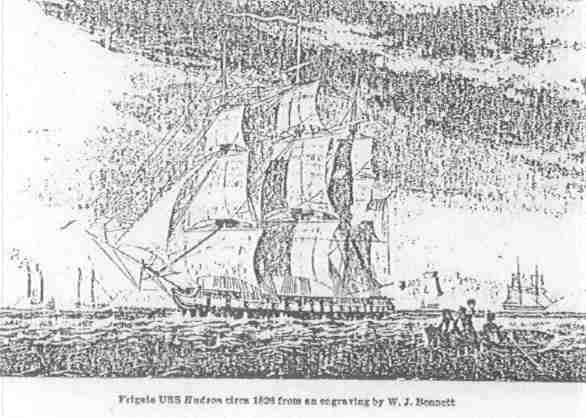Frigate USS HUDSON circa 1826 - 1898
From Tom Reilly WT2

The Frigate USS HUDSON 1898
The second Hudson was loaned to the Navy for use in the Spanish-American
War by the Treasury. The revenue cutter was acquircd at New York 24.
March 1898 and comissioned there, Lt. F. H. Newcombe in commnnd.
Departing New York 24 April, Hudson sailed to Key West via Wilmington and
Jacksonville. There, after brief patrol duty, she was pressed into use as
a dispatch carrier and sent to the Fleet off Cuba.
On the morning of 12 May the gunboat Winslow was diabled by heavy fire
from Spanish shore batteries and five of her crew were killed. Hudson,
under heavy fire from shore, towed the other ship to safety and took on
board the dead and wounded of her crew.
Finally delivering her dispatches to Havana 14 May, Hudson remained
there on blockade duty for a while before returning to Key West. Another
period of patrol ended 10 July as she returned to the blockading fleet
with further dispatches. Hudson captured two small fishing sloops
attempting to run the blocade off Havana. Reaching Norfolk via Key West
and Charleston 21 August 1898.
Hudson Was subsequentJy returned to the Treasury Department.
The USS HUDSON DD475 1942
(DD-475: dp. 2,050;- l. 376.6' ;- b.39.8';- dr.17'9";- s.37k.;-
cpl. 273;- a. 5 5";- 10 40mm.;- 7 20mm.;- cl. Fletcher)
Hudson (DD-475) was launched 8 June 1942 by the Boston Navy Yard;
sponsored by Mrs. Henry H. Hough, wife of Adm. Henry H. Hough (Ret); and
commIssioned ; 13 April 1943, Comdr. Richard R. Pratt In command.
After shakedown and escort duty along the Atlantic Coast, Hudson sailed
for Efate, New Hebrides, where she was just in time to provide fire
support for the initial landings on Bougainville 1 November. As the
Japanese staged a heavy air attack 8 November, Hudson helped repel them
by splashing two "bogies" and assisting on a third. She then made
antishipping sweeps in the Truk area and participated in operations
against the Green Islands 1 February 1944. Enroute to the invasion Hudson
attacked and sank a Japanese submarine 31 January.
Following a brief respite in Australia, Hudson steamed to Kwajalein to
join the armada readylng for the invasion of the Mariannas. After
delivering shore bombardment to clear the way for landings on Saipan,
Guam, and Tinian, the tough little destroyer took part In the Battle of
the Phillippine Sea 19 June. Here she contributed two kills to the
massive destruction of Japanese planes later known as "The Marianas
Turkey Shoot". In mid-July, as the invasion of Guam was launched,
Hudson steamed off the Island to screen transports and chalk up another
"bogie" as well as rescuing three Navy pilots and a Japanese flier. From
the Marianas, Hudson, steamed to Palau to support landings on Pelellu and
Augaur 12-25 September. Departed Manus, Admiralty Island, 4 Octoober,
she.reached San Francisco 2 weeks later for overhaul.
After refresher training at Pearl Harbor, Hudson returned to battle,
arriving off Iwo Jima 19 February 1945. Here she provided vital radar
picket protection during the initial invasion of that enemy bastion.
While retiring from Iwo Jima after the island was secured, Hudson rescued
eight survivors of a B-29 Superfortress which had crashed at sea 8 March. Her next action came as she assumed duties as a radar picket ship off Okinawa 1 April, when American troops stormed the last enemy stronghold before the Home Islands. On 5 April the vallant Hudson gained credit for sinking her second Japanese submarine of the war as a 6-hour attack with six barrages of depth charges resulted in the death of RO-49 off Okinawa. Although under allmost constant attack by kamikazes, Hudson was to come through the war with only one injury to a crewman; that was inflected when a kamakaze crashed close aboard 22 April 1945, clipping a chief on the head with a wingtip but missing the ship.
It was off Okinawa that Hudson earned the title of the."destroyer" who
saved a carrier." On 4 May a kamikaze crashed in the escort carrier
Sangamon. Hudson steered for the fiercely blazing carrier, Despite the
exploding amunation on board the drifting carrier, the superbly managed
destroyer was able to go along sid three times getting a total of 10
hoses over the side. The overhanging flight deck of the carrier caused
exteme damage to Hudson superstructure as burning debris and a flaming
plane jettisoned by Sangamon's crew which crashed Into Hudson's debth
charges on the fantail -- caused scattered damage. When the fires were
finally under control, Hudson had suffered damage equal to that of the
origilnal victim, althhoug the carrier had been saved with small loss of
life through the destroyer's efforts, and was routed to Guam for repairs
10 May.
Promptly repaired, Hudson joined the 3d F1eet off Okinawa 22 June and then
proceeded to Eniwetok for convoy duty in the Marshalls. After escorting
a convoy to the Aleutians, she returned to Northern Japan to take part in
the occupation and control of the enemy home Island 8 September, 6 days
after signing of unconditional surrender in Tokyo Bay From Japan, Hudson
sailed to Alaska where she began carrying veterans back to the States in
Operation "Magic-Carpet." She then put in at the Puget Sound Navy
Yard, Bremerton. Wash.,to prepare to decommission, Sailing to San Diego
15 March 1946, Hudson was decommissioned and went into reserve there 31
May. In January 1947 Hudson was moved to Mare Island, Calif, where she
remains.
Hudson received nine battle stars for World War II service.
Return to Tom Reilly Photo Page
Return to Contributors page
Return to Hudson Home Page
|